Published on September 11, 2019 at 10:53 AM
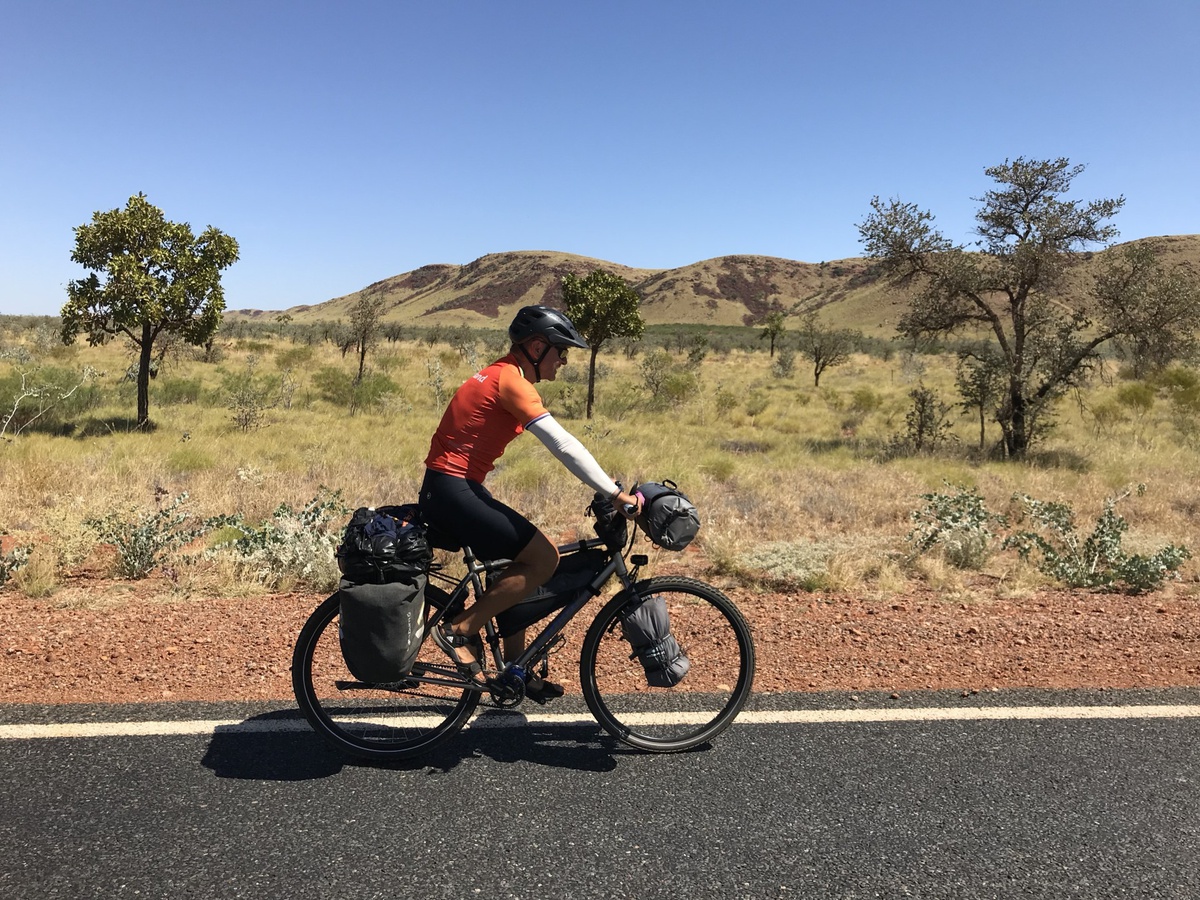
By reaching Broome we leave The Kimberley behind us and Pilbara is coming up next. Pilbara is roughly the northwestern part of (Western) Australia and the most characteristic of the area is that it resembles Mars with all that red sand, red rocks and red hills. Were it not for a lot of grass growing, nice green after the wet season, but now yellow, which is also nice. If there is green vegetation, then it are shrubs with thick leaves or the leaves of the gumtree with a characteristic white bark. It is a pity that the boab tree we love is no longer there.
All that red is due to the presence of iron that oxidizes to the outside air: a lot of iron ore is extracted and the area has many mines that entail some (ugly) activity. So in fact, Pilbara is completely gray but we see red from rusting iron. Despite the mines Pilbara is, like The Kimberley, an extremely sparsely populated area. The Karijini National Park is right in the middle of it and is perhaps the most beautiful national park in Australia and according to many a must-visit. Are we going there or are we ignoring it? We postpone that choice.
In Broome we had two wonderful days of rest. All the odd tasks that are characteristic of such days are fully facilitated by Warmshower’s hosts Max and Fleur, so that there was plenty of time for “relaxation”. The bikes, camping equipment and clothes are clean and repaired and the big blue ‘feed bag’ is packed again. Max showed us a lot about Broome (including both bike shops) on the bike and on the last day he takes us to Cable Beach in the 4WD to admire the legendary sunset from the beach. Thanks to the hospitality we cook Turkish pizzas (Lahmachun) the last evening for Max and his son Oliver and bake another cake on the day of departure.
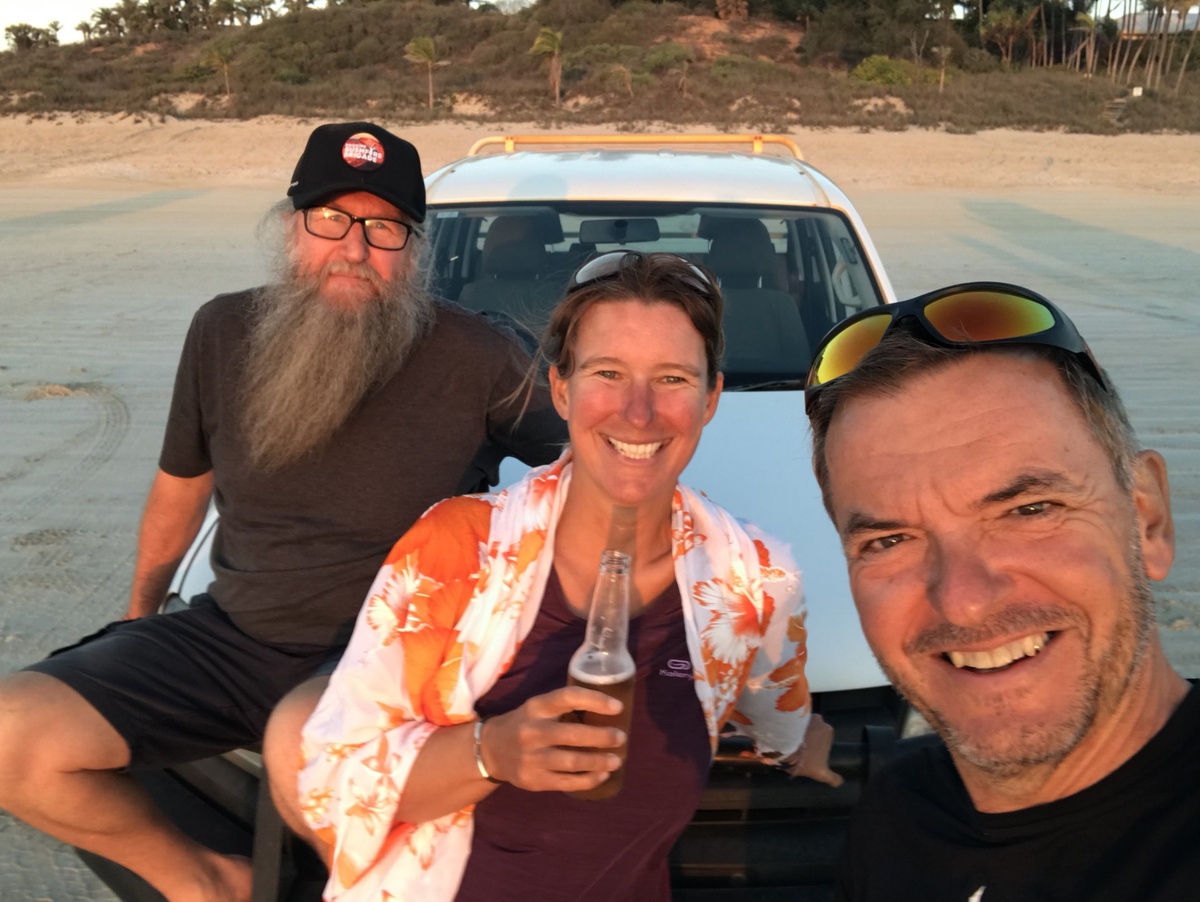
Enjoying the relaxed atmosphere, also known as ‘Broome time’, we jump on our bikes just after noon but quickly stop at the side of the road. As in the Netherlands, the sidewalk annex cycle path does not have all the options for intersections. In this case, if we want to turn left to leave Broome, is that option missing and we push the bicycle from the cycle path to the road through the red sand with roadside grass cuttings. What we do not see, but a little later, is that the grass cuttings are full of thorns and our tires have therefore become a kind of second skin. We stop to pick all the thorns out of the lanes and often prick ourselves. You cannot imagine that the tires will not deflate after so much terror. Half an hour later all thorns seem to have been removed from the tires and we still cycle out of Broome full of disbelief on still full tires. Good job Schwalbe tires.
We have plenty of time today, because it is only a short leg (40 km) to the nice Roebuck roadhouse, which we also visited on the way to Broome. When we check in we are approached by Phil: “I know you from Adelaide River!”. Yes we remember him, although it’s more then a month ago and we didn’t really get acquainted then. Phil has also just arrived at the roadhouse. He and his wife Robin appear to be standing next to us at the campsite and offer a cold beer. They are very interesting people full of stories, free-thinking and we grab our seats. Phil and Robin are originally from Melbourne and have been traveling around for three years now. There is no more house (like us). Phil is like Harry an heart patient and has seven or eight stents; he did not count them accurately. Between our bikes and Phil’s caravan, a man parks his fully loaded pick-up truck with a trailer with two quads. He is immediately invited by Phil to give further explanation about this equipment while enjoying a beer. Camping neighbor Lyndon is here for work and searches in the outback on his quad for minerals for a mining company and then sleeps in a swag. Phil also has a swag, brings it out and we put it on and go for a test run. Quite comfortable but the thing is incredibly heavy and therefore unsuitable for bicycle camping.
A new guest arrives at the site. It is Jerry with his folding trailer and after he has set up that thing he is also invited toi “join in!!” Jerry lives on Kangeroo Island off the coast near Adelaide and speaks authentic Australian English (and also looks like an “authentic Aussie”) while he is originally a Dutchman from Heemskerk. In the meantime we all drink beer, too much for us until Lyndon invites us to eat at his expense at the roadhouse. Jerry, Phil and Robin drop out and we gratefully accept his offer and devour a plate full of fries, a schnitzel of an oversized chicken under a roof of tomato and cheese with a mini salad. Lyndon believes that more should be drunk and puts a bottle of wine on the table. No, no more alcohol, but he is already filling the glasses. It has been dark for a long time and the light has long gone out of ourselves when we pitch the tent in misty condition. Not bad at all, we find ourselves and we drink liters of water at night. That should not be sufficient: the next morning we get up with a hangover.
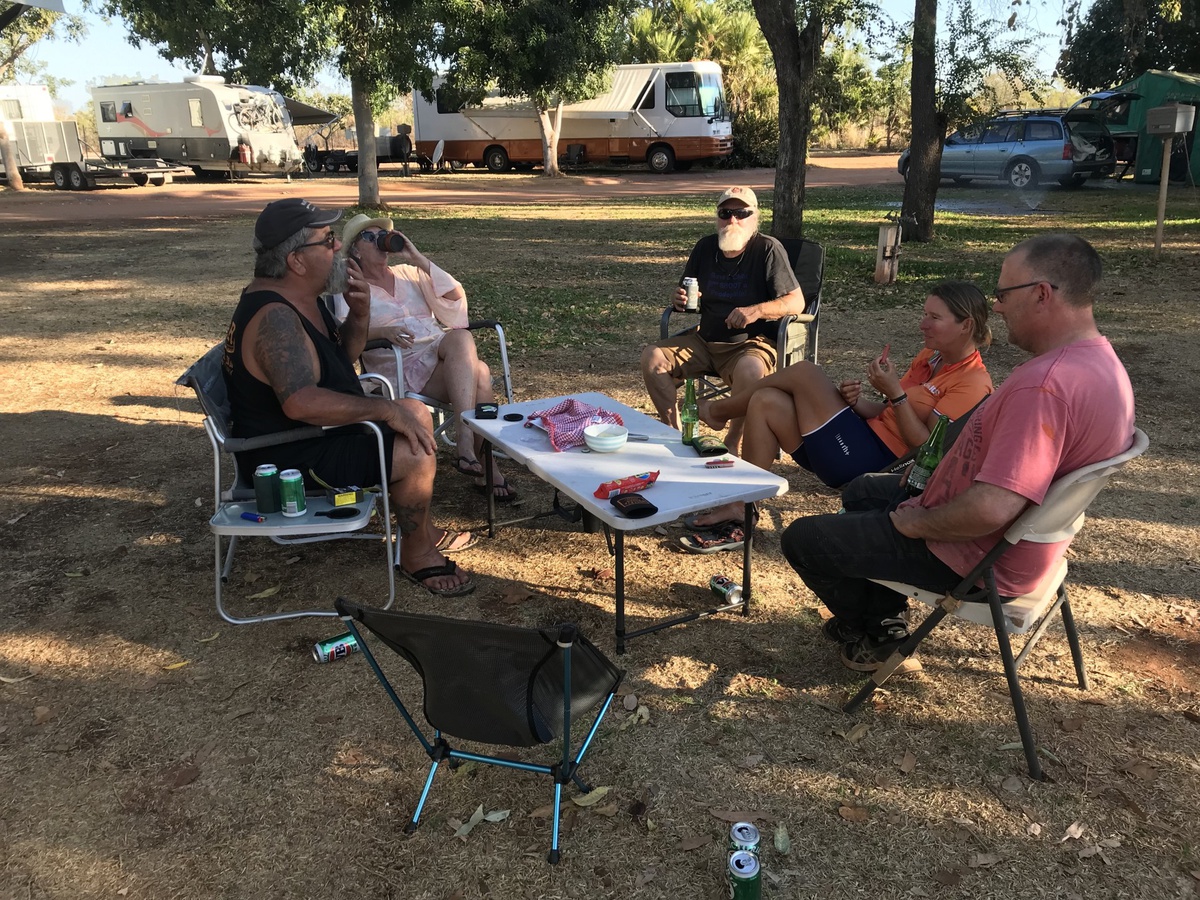
The hangover is somewhat fought with a hearty breakfast of a XL bacon, cheese, sausage and egg sandwich. That everything is not going very well with us, is evident when Harry leaves his helmet and Roelie her phone in the store. The girls of the roadhouse look for us to return them. Later, about 10 kilometers after departure, it appears that we have forgotten to hand over the key to the amenities. Cycling back is not an option. We decide to stop an oncoming car with the request to hand over the key and that is how it happens. Whether Mr. Bully and Mrs. Grumpy will grant our request, we have to find out from the credit card details. Oh well, a new helmet and a telephone would have been more expensive and we still have them on us.
Lyndon predicted a great cycling day after the alcohol boost. Apart from the fact that the brains don’t function optimally, the legs are indeed moving around nicely. When we approach the exit to the Barn Hill Station campsite on the coast after 80 km, a shower and drinking water are too tempting. The alternative is Goldwire rest area on the highway and there are no facilities but a dump toilet. What we have not taken into account is that the nine kilometers between highway and beach is an incredibly awful road with loose sand and lots of corrugation. Halfway through Roelie, grateful takes up the offer of a lift by Michele and Peter. Peter lifts her bike onto the trailer and brings her to the campsite. Harry perseveres, cycles the wrong way, and arrives total exhausted.
The rotten dirt road leads however to a beautiful campspot on the coast where we can pitch the tent on a slightly higher ledge overlooking the Indian Ocean. When the tent is up we walk to the sea. Before descending to the beach there is an outdoor shower on the cliff where Harry showered off the dust. Roelie walks further (a long way because the low tide) for a swim in the sea. What a wonderfully cool end to this hangover day. We let the evening activity of the campsite (lawn bowling) pass by and enjoy the sunset at our tent and cook a pasta with a bit of sand in it, as it should at the seaside.
At 7 am Peter and Michele once again offer a lift on that awfull road. This time Harry join in. Even with the 4WD it takes more than half an hour to get back to the highway. After 9 km we reach the sealed road and say Dutch style goodbyes to Michele and Peter with three kisses as they know from their overseas trips. Michele takes a few more pictures of us as we cycle away and sends them to us later via email.
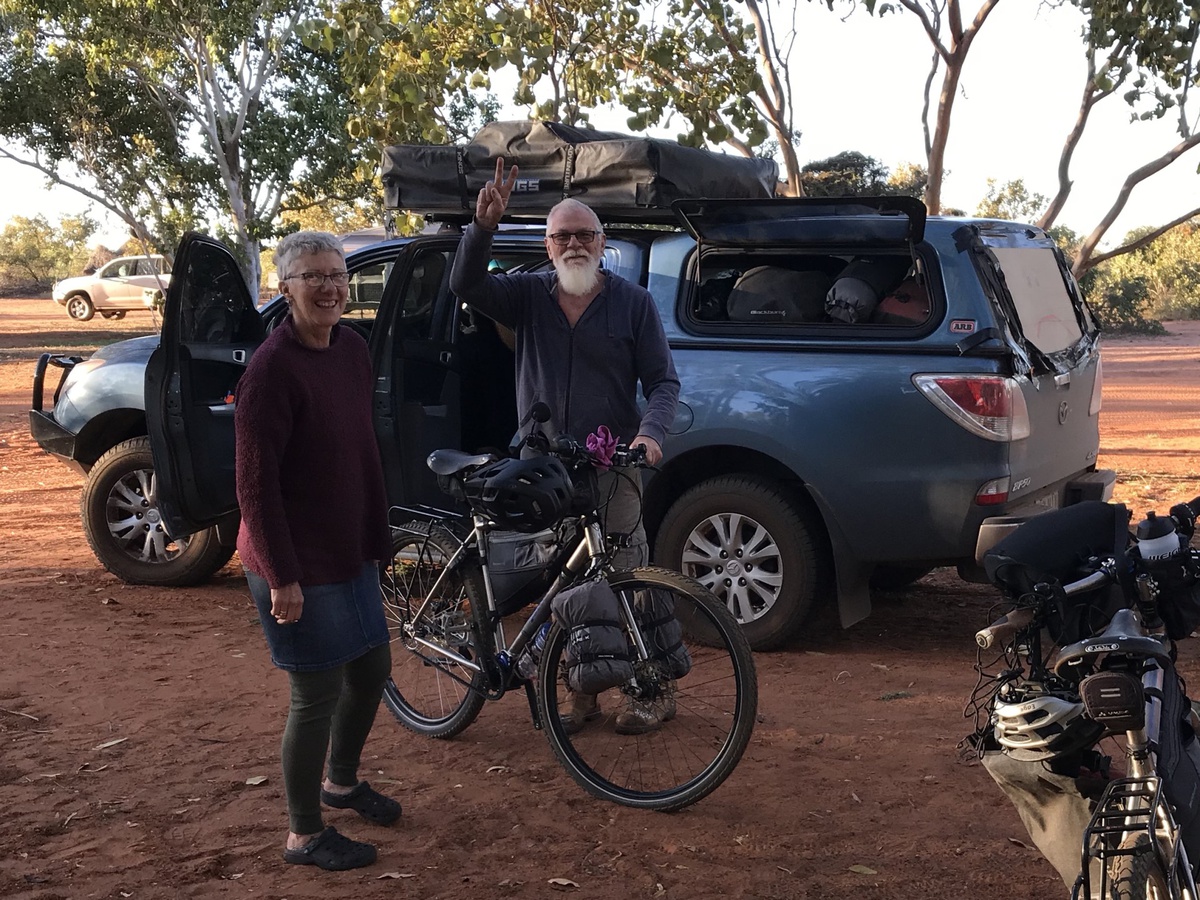
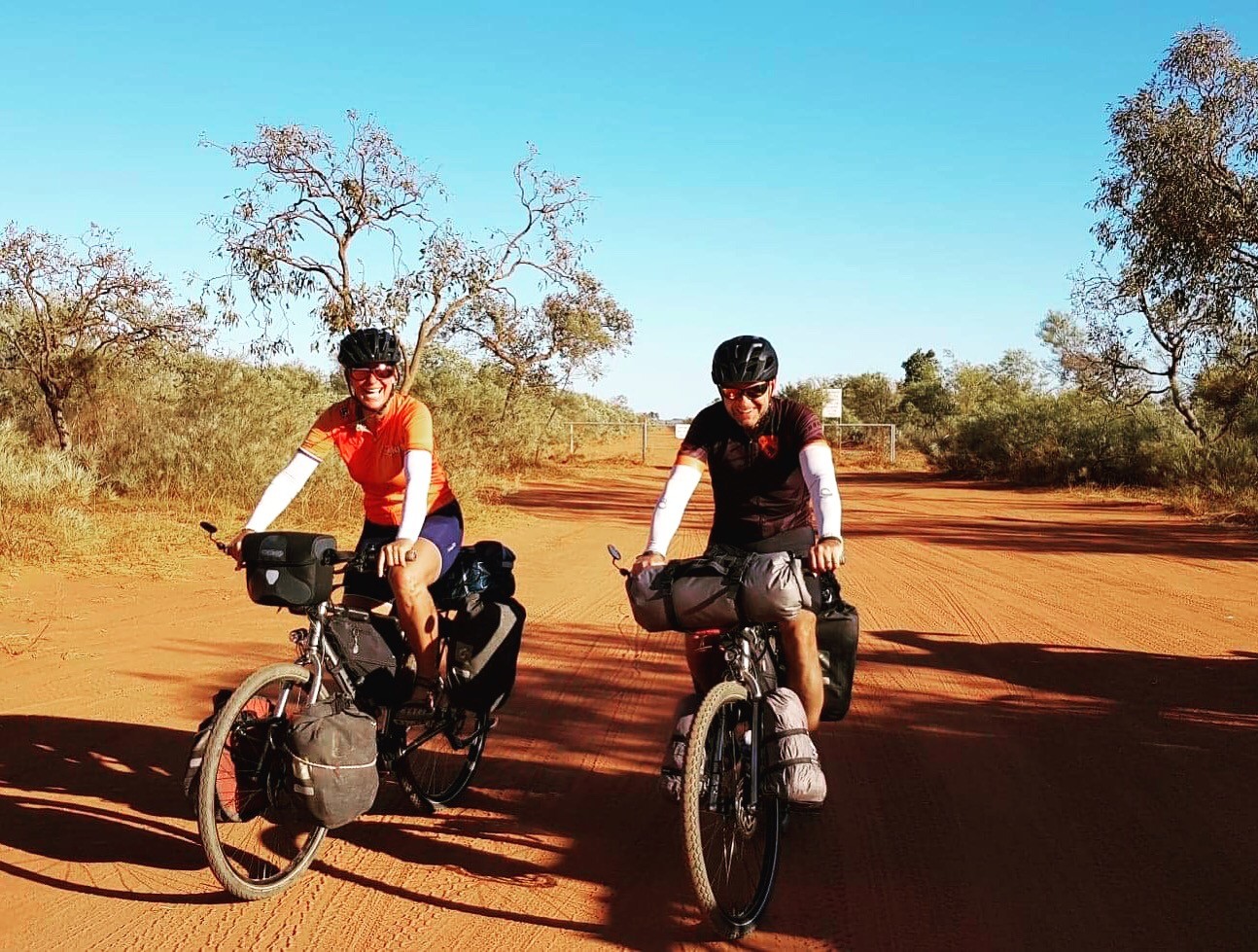
A tailwind brings along the idea to cycle to Sandfire Roadhouse in one day, 190 km, but the wind soon disappears completely and just after noon we decide to stop at Stanley Rest Area, an ugly, bare and large parking lot. We feel a bit lost and there is only little shade.
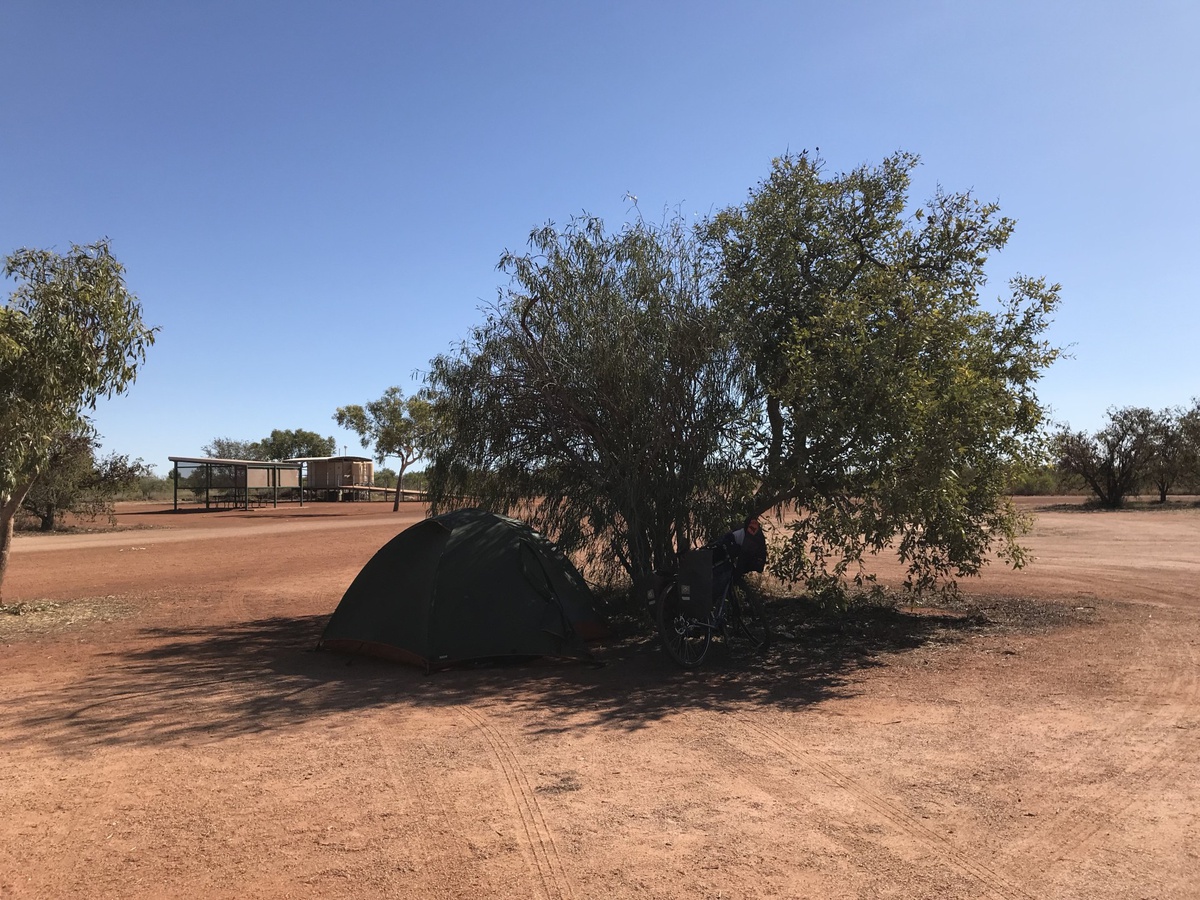
What remains is long wait until we can cook diner but thanks to a number of other tourists the afternoon flies. First we chat with Bill. He was born as Willem in The Netherlands and after living in South Africa with his parents ended up in Perth. He just stopped working and is now able to travel full time, although it seems as if he has not quite found his way yet. Ian & Doth, on the other hand, seem to be fully established as traveling pensionadas. They live in Perth and offer to fill our water bags while offering a cold beer. In fact, everything that is cold and drinkable is incredibly tasty in the afternoon, including this beer even after the overdose of the other day. Despite of wintertime it is pretty hot in this part of Australia and so is our drinking water. In the evening we cook a creamy pasta (this time without sand) and send Fleur, our warmshower host in Broome, a message that we don’t need anything. Fleur drives towards us tomorrow after a course week in Port Hedland and if we needed anything, we could ask her. We don’t need anything. We have enough stocks left. Fleur responds that she is going to bring something anyway, just some treats.
It’s still dark as we break down the soaked tent early the next morning. We guess that this dew brings a bit of relief to a lot of flora and fauna in the dry season. During the day, the humidity gets down to 5 and it gets hot, often above 35 degrees. At night the temperature drops to 15-18 degrees. Early in the morning the hands and toes are cold and there is a drop hanging under the nose. When we start cycling, there is usually little wind at first and since Broome we get a headwind and we struggling against it in the heat of the day. After 30 km it is time for “hulk powder”, the potion out Broome’s supermarket. The white powder turns green in water and makes the water sweet, ionizes and supplements the minerals lost through sweat and gives us inhumane powers after consumption.
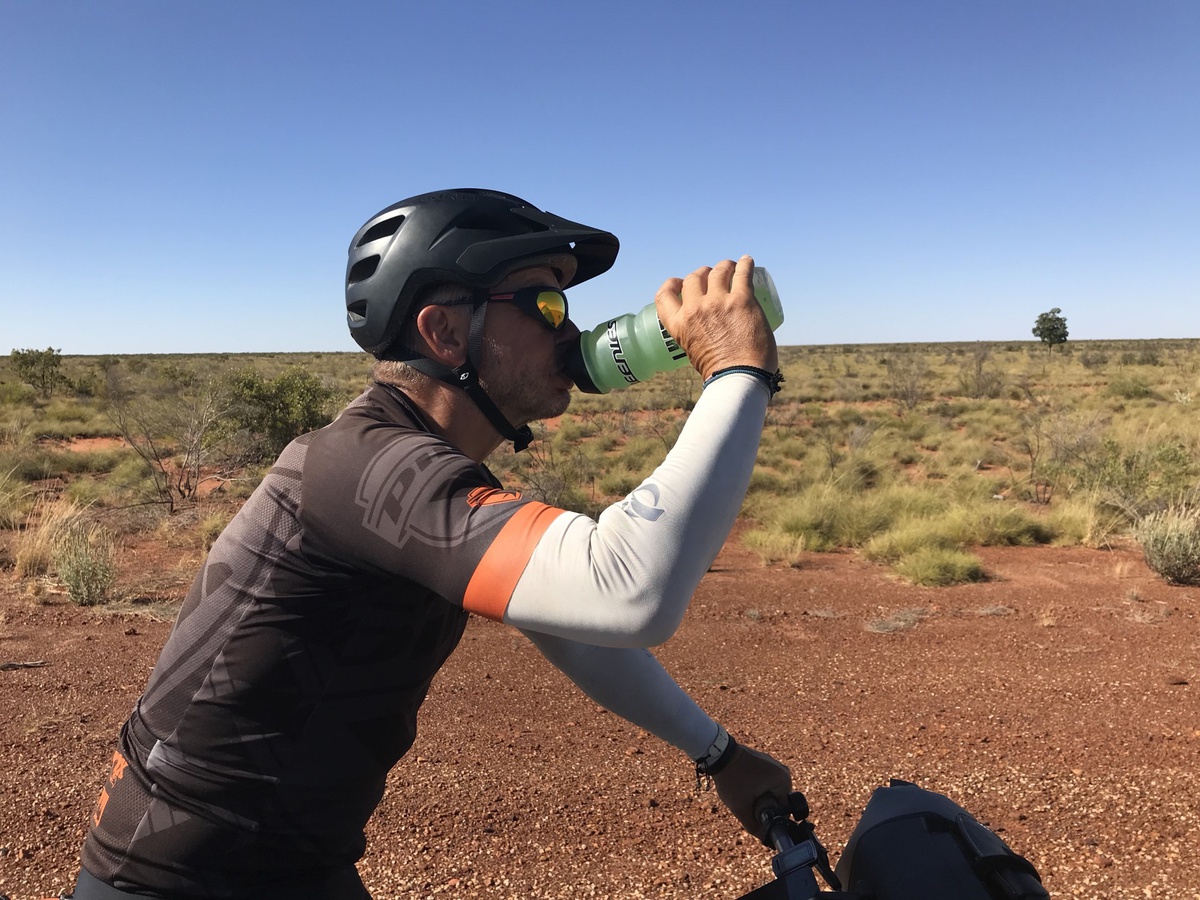
The landscape is becoming increasingly bare. Towards the end we reach a vast prairie plain with one tree. We discus whether the tree needs to be felled. Harry thinks it is a dissonance and is for felling. Roelie opposes because it can offer shade for a cow or a land place for a bird, which we hardly see here in this area. In the distance we see a red long wall that seems to merge into a fata morgana in both the east and west. We fear a final climb in the bright and hot afternoon sun. However, we first cycle along side and then bend off considerably so that we have a nice tailwind for the last 5 km and withstand the slight difference in height with ease.
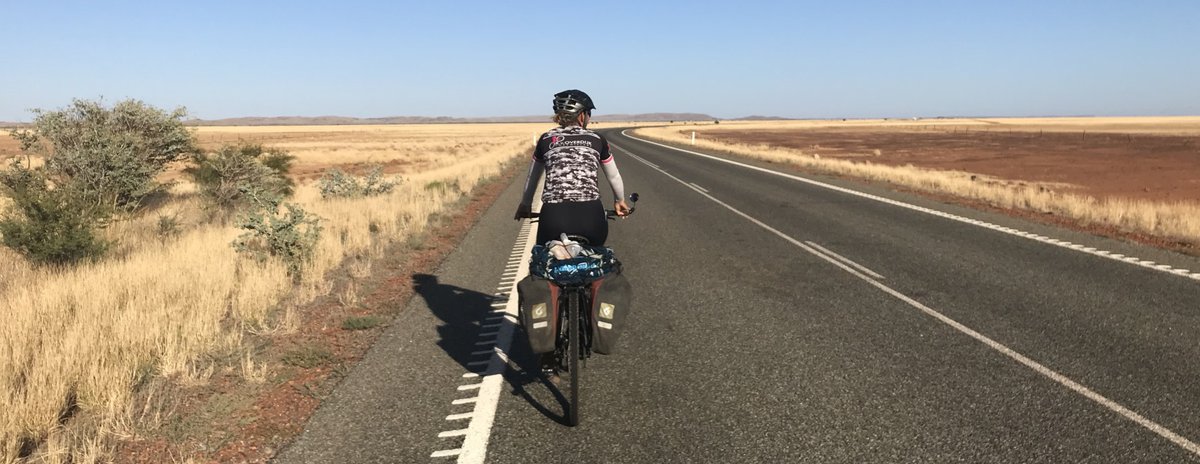
Roadhouses in the outback are like oases in the desert. The Sandfire roadhouse is no exception. And it becomes even more beautiful when we meet Fleur at the entrance and she shoves us a bag in the hands among others filled with water, wine, fruit and weetbix. We talked to her about this typical Australian breakfast product in Broome. It is a compressed and completely tasteless cereal. Fleur has added packets of milk and honey to give some taste to it. Roelie wasn’t a weetbix fan 18 years ago, let’s see what Harry thinks. Fleur is also curious about the outcome of this experiment. Result: mwah …
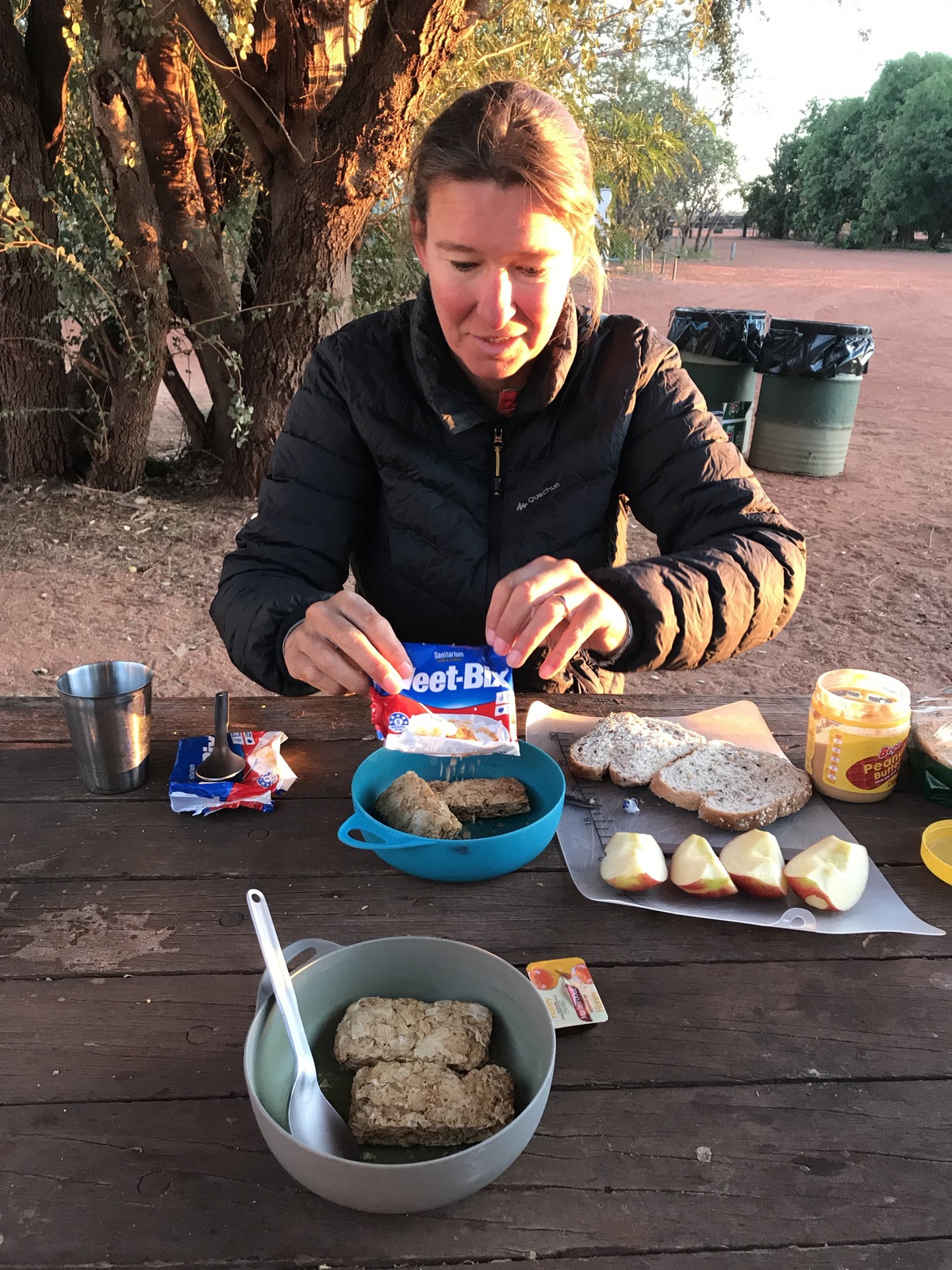
When Harry signs up for a spot at the campsite behind the roadhouse, he immediately has a click with the hostess. She gives him tips and a map and when she brings our ordered food (sandwich and hamburger) she tells Harry: “the food is on the house (but don’t tell anybody else), it’s amazing what you’re doing! ”
We take the soaked tent out of the bag and after two minutes, it is completely dry again. The low humidity is handy: the tent and also laundry dry very quickly, but our lips, hands and feet also dry out and we constantly lubricate with lip balm and cream. Then the red sand of Pilbara sticks extra, which is not very nice. After the tent is pitched, we get a shower; oh how nice that is after the bathing yesterday with only wet wipes.
Of course the wind is a thing here in the immeasurable and flat country, you understand that too. And we understand that we should not keep writing (cheering or whining) about the wind every day otherwise you will stop reading. We will try to restrain ourselves, promised! But the forecasted tailwind of the morning isn’t there and the strong headwind predicted for later in the afternoon starts already at 11 am. Harry is developing a special form of sigh today, a form of complaining without nagging. Roelie does not believe in sighing: it doesn’t help, “but not sighing doesn’t helps either,” says Harry.
At the start of the long leg to Pardoo roadhouse, Roelie comes up with a stupid idea that is (or precisely for that reason) immediately embraced by Harry. We still have doubts about visiting Karijini NP and could reach Perth by the end of September. That means a month left on our three-month visa and plenty of time to continue cycling. First we thought about a round trip south of Perth, then the idea occurred to fly to New Zealand earlier and now Roelie comes up with the idea to continue cycling from Perth to Adelaide and cross the epic (and absolutely empty) Nullarbor, with the longest straight (horizontal and vertical) stretch of road in the world. We will sleep on the idea for a few more nights. In Port Hedland, we have to make a choice as to whether we will turn to Karijini or not.
Ever since we left Darwin, we are being greeted by the oncoming traffic. We estimate that 7 out of 10 from all vehicles wave at us. We ourselves begin to “classify” the sweepers: 1 star for one or two fingers up without releasing the steering wheel; 2 stars for lifting a hand up; 3 stars for a waving hand, 4 stars for thumb up and 5 stars for a any nice combination or variation like honking and stick an arm out the window and wave before a thumb up. And the non-greeters? We think they must be the Europeans in the rental campers, supplemented by Australian fishermen with a boat on their roof or on a trailer. Exceptions exist of course.
In addition to the swingers, there are now a number of people who help us along the way and who we called “trail angels” in America. On our website they come on the page “Friends on the road” and two big heroes parked their campervan on the side and hold up cold Gatorades: Bruce & Cathy, it is the third time we meet! Soon we sit in the air-cooled camper with a lunch and a cup of coffee chatting about our new Nullarbor plan. Some time later, the plan is off the table and there is a new plan to cycle from Adelaide to Sydney along the coast. A totally different part of Australia. The Nullarbor would be more of the same: endless plains without trees and enormous distances between roadhouses. The southeast coast will have the most beautiful cycling routes and unlike here has many villages and towns.
With this new plan on our mind we cycle the last tens of kilometers in the direction of Port Hedland. 15,000 people live in Port Hedland, making it by far the largest city in Pilbara. The city was actually founded for only one reason, and that is the export of iron ore from the many mines south of the town: it has a gigantic bulk port where large ships are constantly being filled with iron ore transported by road trains and extremely long fully automated trains. Not a very nice place, and that’s why we seek refuge in a caravan park in South Hedland some ten kilometers below the harbor.
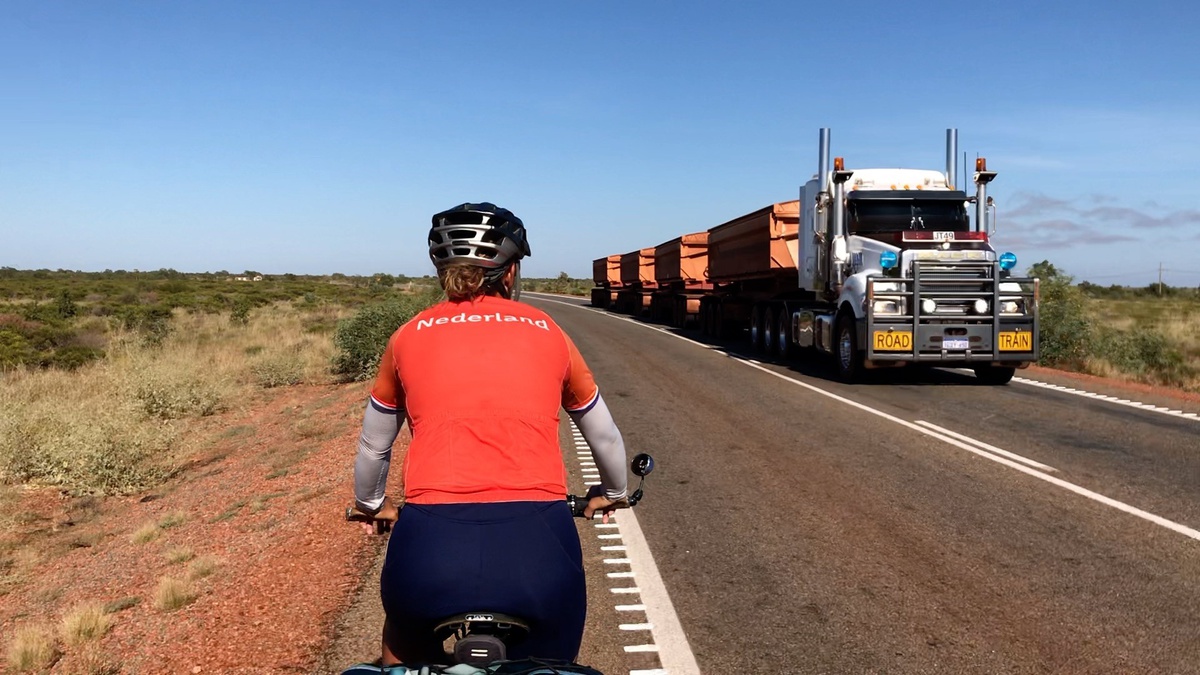
At overnight places there are always people who come to us and say: “we have passed you today (yesterday, last week, etc.)!” Now Bob comes to us: “you must be the two Dutchies” and tells he has met Henry, who told him about us (we cycled about 10 days with Henry through The Kimberley on the way to Broome). Bob and Henry stayed in the same rest area the day before yesterday, and is doesn’t take long that we find out that Bob is also traveling by bike. How nice, another cyclist and stories! He says that, just like Henry, he is trying to complete the tour of Oz. For him that means now the stage from Darwin to Perth. His wife cycled as far as Broome and now he is on his own and that takes some getting used to again. After some motivation problems, he will continue tomorrow and he expects us to catch up soon. That does not happen (soon) by the way. We take a day off and in the first few days it turns out that we not only cycle exactly the same stages, but -according to other travellers- also put the tent in exactly the same place.
When we get on our bikes again, we first have to flee the logistic ant nest south of Port Hedland. We cycle another 30 kilometers on the Great Northern Highway, which is used very intensively by the incoming and departing road trains. It is certainly not relaxed and we are happy that after those 30 kilometers we can turn off and take the North West Coastal Highway. Our good old Great Northern Highway continues in the direction of the Karijini National Park (which we will definitely not visit) and luckily most road trains also go that way. We calculate that we have cycled on the Great Northern for about three weeks, with the exception of the trip to Broome and shout “Thanks and goodbye!”
On the new highway, the North West Coastal Highway, you get informed immediately about the many sights, accommodation options and cities along this route. Oh yes, Whim Creek -a hotel with café- is bankrupt and therefore closed ….
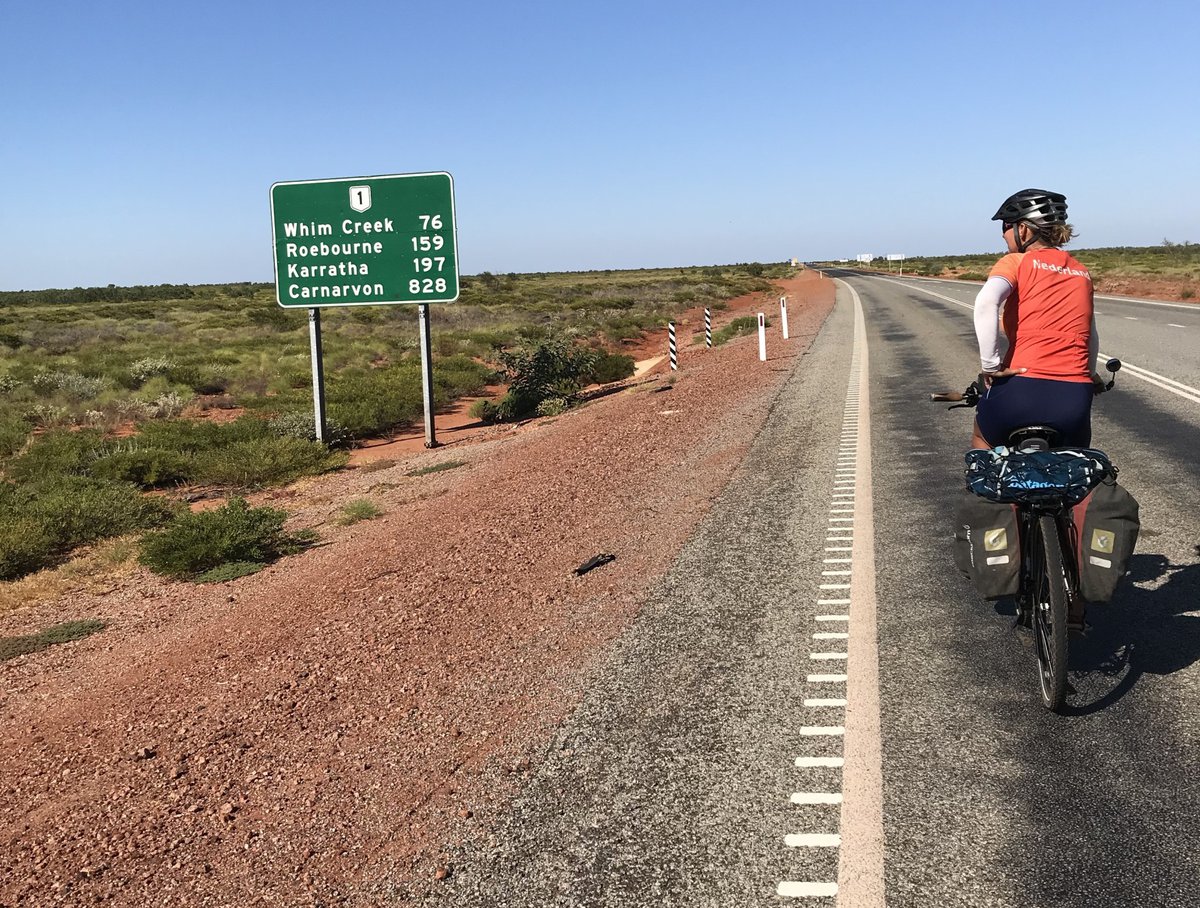
The route is boring the first half of the day, followed by a pretty nice second half with more and more wild flowers. We have set our goal on reaching Sherlock River at 137 km, a stop that is not on the map but on WikiCamp and so we know that we will finally camp again (and for the first time in Australia) at a river with running water. With this motivator we reach the place quite early in the afternoon. Roelie takes a dip in the river which unfortunately is not deep enough and also not very cold. We can finally fill up our water supply by filtering water ourselves, but that is not necessary because our neighbors offer to fill our water bags. Our advanced but also heavy Swiss waterfilter once again enters the bicycle bag unused. Since our departure from the Netherlands 14 months ago we have not had to use the filter.
After Sherlock River we actually cycle into and through a village with inhabitants. It is called Roebourne and looks pretty neat and tidy. We stop at the general store annex coffeeshop that is apparently run by Aboriginals with – like everywhere in Australia – the help of backpackers.
From Roebourne we cycle over a dry, bare plain to Karratha, a town on the coast that unfortunately has no camping in the village itself but on the industrial estate five kilometers south. We pitch our tent next to the camp kitchen and head for the supermarket in the city center. For dinner we buy pasta, pancetta, broccoli and blue cheese. It takes a while to cook it because there is a strong wind and the fire of the kitchen stove always blows out. That does not matter at all because we meet Trish and David from Melbourne, who are barbecuing next to us and meanwhile we are having a nice chat about traveling. Trish was born in the Netherlands as Patricia, but emigrated to Australia at a young age. The next morning Trish gives us muesli and their address and telephone number in case we visit Melbourne on our way to Sydney.
The next town after Karratha is Carnarvon on the west coast. It is “only” 650 kilometers away. At least on our route, because on the way you can leave the highway to visit the isolated coastal villages of Onslow, Exmouth or Coral Bay. Onslow probably is not worth a visit, but Exmouth in combination with Coral Bay seems to be interesting. However, that would mean a detour for us for a week. With our new plan to reach Perth around September 25, we stay on the Highway and cycle directly to Carnarvon.
On the map we study the possibilities to spend the night and store water. There are three roadhouses between Karratha and Carnarvon, on those 650 kilometers. We think we can reach Carnarvon in six stages, but we hear from our cycling friend Henry – who cycles three days ahead of us – that the wind is very “against” in this area. Six stages, that is five nights and we are looking for a number of potential rest areas on the map where we could pitch our tent. In the supermarket we buy enough provisions for these five nights; a roadhouse always has a small shop, but most of the time they mainly sell soft drinks and souvenirs and hardly any food (with the exception of some fast food for the drivers of the road trains). In all cases, they are very expensive.
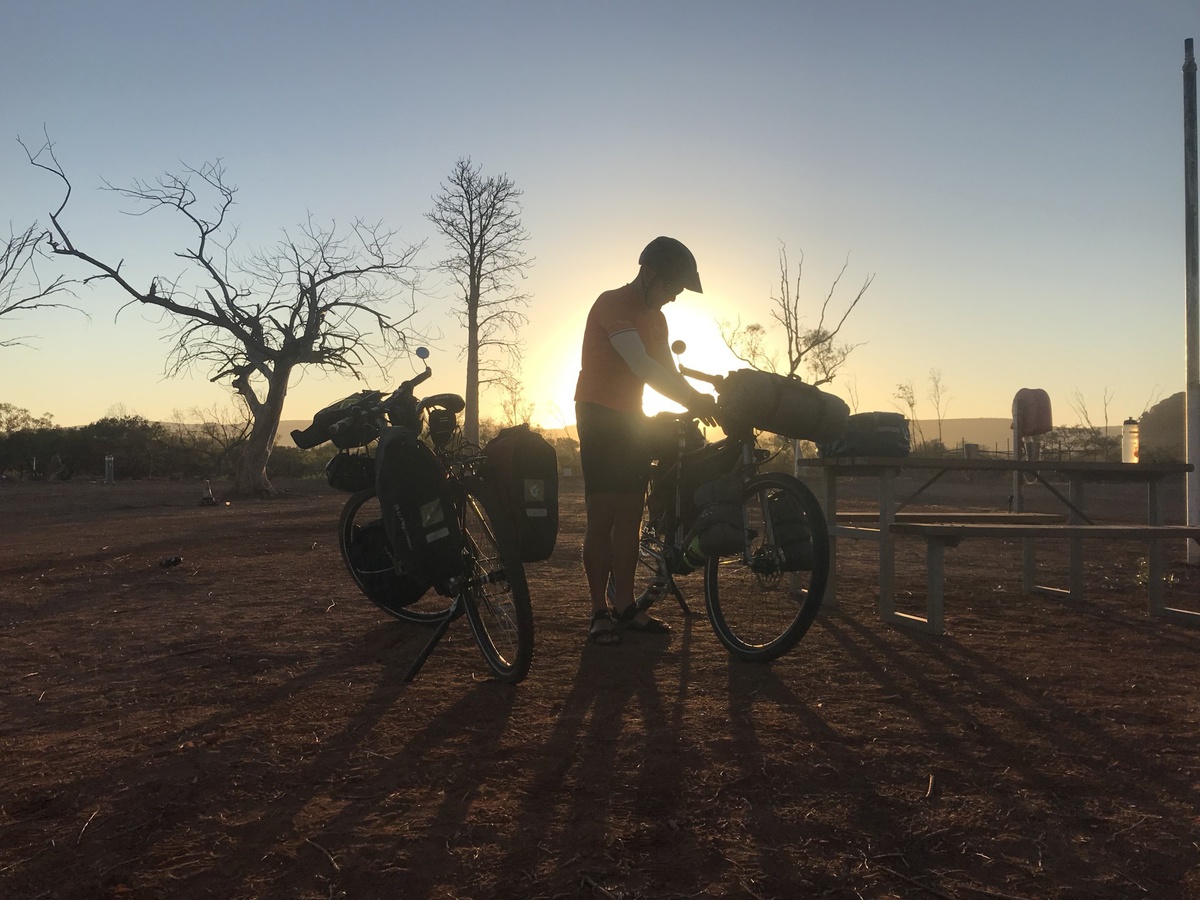
Fully loaded with supplies and water we cycle to the southwest. Every day we cycle over 100 kilometers with an abnormal 165K on the second day. This way we reach the first two roadhouses, to camp and have a shower the first two nights, while on the second day we arrive at the Nanutarra roadhouse, together with Bob! Bob does not cycle with us the next day because he takes a rest day. But in the evening, he comes and sits at our table with a steak sandwich from the roadhouse to chat, while we cook our favorite cyclist meal: pasta. After this meal a couple of people come up from the dark, “Hello again!”, it sounds. It’s unbelievable, but it’s Bruce and Cathy! It soon turns out that this reunion does not have a nice reason, because Cathy suddenly had problems with her right eye in the Karijini National Park. A doctor from Tom Price near the park looked at it, but did not have the necessary equipment for examination or treatment. Nevertheless, he was able to reassure Bruce and Cathy that there is probably nothing serious going on. They are now on their way to Karratha so that a specialist can check and hopefully help Cathy with the necessary equipment.
Unfortunately no roadhouse at the end of stage three: the goal of this day is a rest area without a picnic table, without shade and only a toilet, the door of which would have been kicked in. There are two other rest areas on the route that get very good reviews on WikiCamp, but they are too short or too long a distance. We also fear a water shortage, because we expect that, beside us, it’s possible that nobody will spend the night in this ugly parking lot and whom could give us water. That is why we are not really looking forward to today and get rather slowly out of the tent. We cannot imagine that it will be a very beautiful day…
When we pack the tent, Bob comes again to chat with us. The people of a supported cycling group walk by to have breakfast in the restaurant of the roadhouse and have a chat, just like yesterday. We ask the person who has to drive the following car today to put a jerry can with 10 liters of water on the rest area for us: “no worries” he said, which means one less worry for us. Bruce and Cathy also join during breakfast. It’s nice and we prepare an extra cup of coffee to postpone the departure and farewell.
Already after about 10 kilometers the supporting car of the cycling group is on the roadside and we see a bicycle on the head next to it. One has a flat tire and gets help. Now that the big bicycle pump is already being used anyway, it is offered to also provide our tires with an extra ‘puff’. With nice hard tires we then ‘fly’ over the road. It saves just a little extra resistance.
Trish and David from Melbourne come to ride next to us later and ask if we need anything else. We met them while cooking at the campsite in Karratha. “No, we’re still good, thank you!” is our answer. While we roll, we chat a bit, before they press the pedal again, “come and visit us in Melbourne!”, they shout through the open window.
After about 60 kilometers we turn into a parking lot with picnic tables. It is a warm day and we are happy to sit in the shade for a while. Soon two German ladies join us and who are probably interested in our trip due to their origins in cycling town Tübbingen; it seems like a long time ago we stayed near that city on our worldbybike tour. In the meantime, the ladies offer us water, cucumber and tomato. When the ladies drive away, another couple drives into the lot and they enthusiastically shout at us that they have seen us at Barn Hill Station before. Moments later they are at the picnic table with two ice creams and soon we’re enjoying this ice-cold bar of mango-coconut ice cream.
After another 40 kilometers, a rented camper parks on the roadside and two people get out of the car, gesturing to stop in the shade of their vehicle. We don’t say no to that. The country has been flat and bare for miles and a bit of shade is a luxury. They are called Greig and Lindee and then they tell that they met Bob at the roadhouse and brought a bottle of cold soda: a gift from Bob! They also give us some fruit and meanwhile they tell us that they are from an island in the Dangar river in New South Wales, now have two weeks of vacation and a lot of cycling. There is a nice chat while we finish the bottle. Meanwhile, Greig wants to know everything about our bikes, especially the Pinion gearbox.
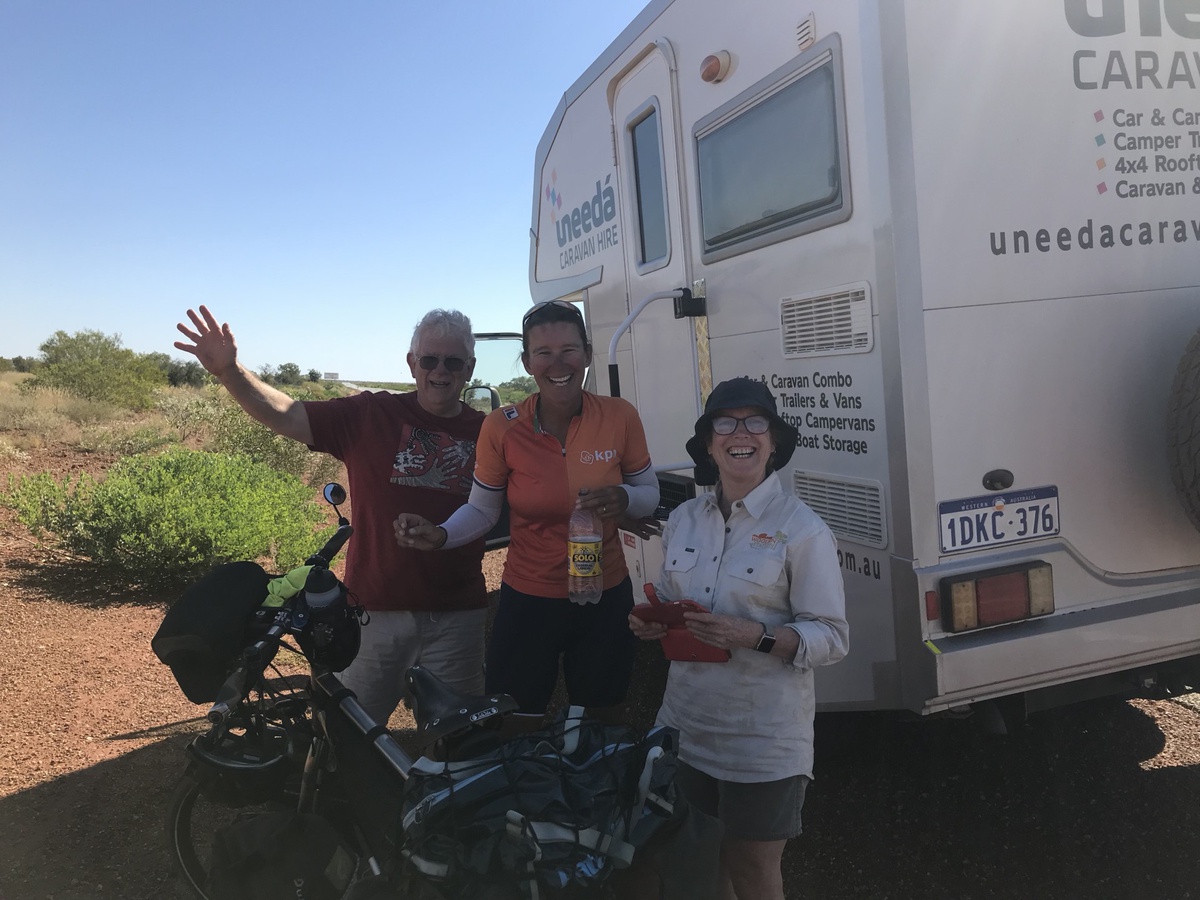
We then do the last 10 kilometers with a smile on our face, which disappears when we arrive at the restarea. It is indeed a sober, dry, dusty place, but fortunately there is an information board about the Exmouth region with a roof and a remnant of bench that apparently vandals have overlooked. There we plop down and look for the jerry can with water. We do not have to search long and see that the jerry can is “tagged” to ensure that others stay away from it. Shortly afterwards Simon and Caroline from Tasmania park in their tough 4WD. They decide not to spend the night here and continue to drive but they keep chatting for a long time and in the meantime he pulls two cold beers out of the fridge for us; for a moment we imagine ourselves in seventh heaven.
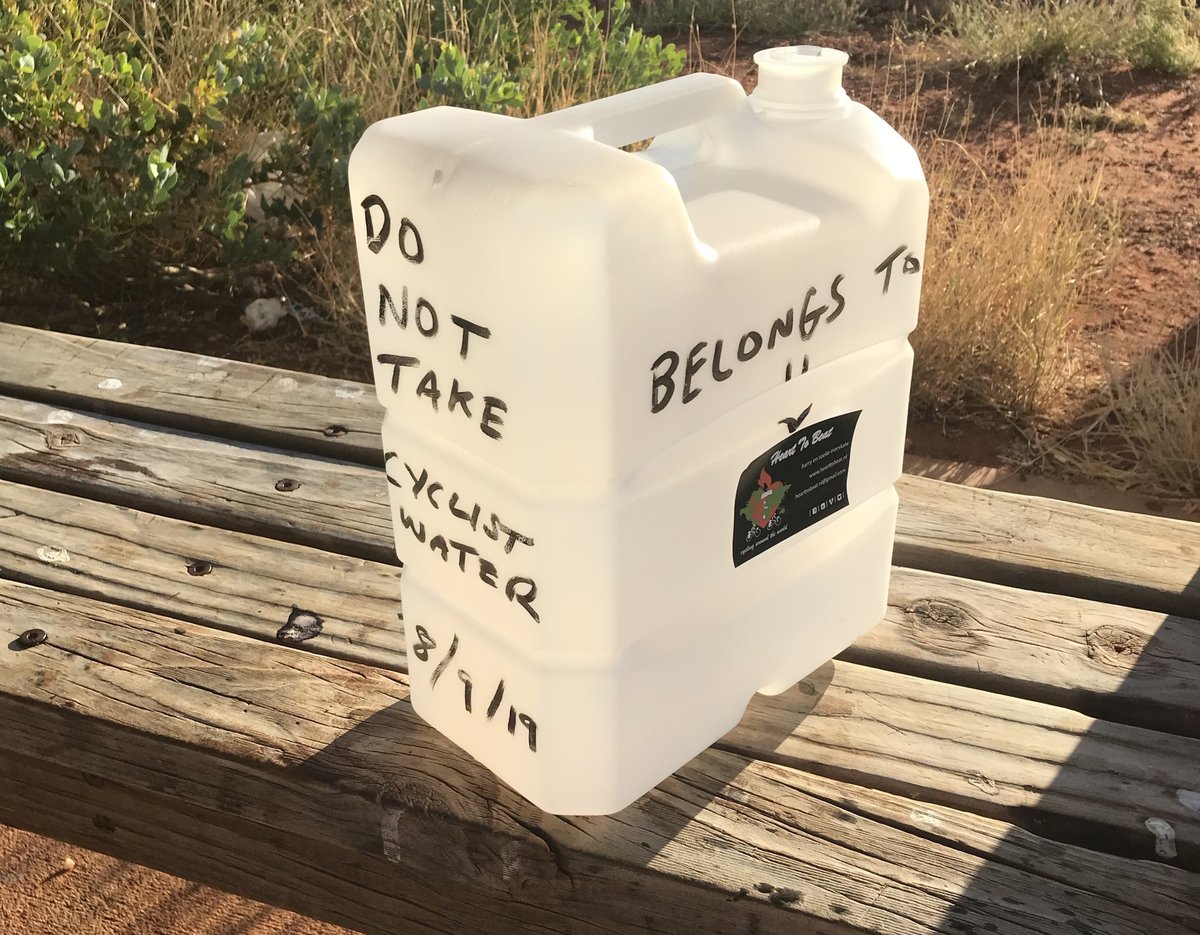

After their departure we look for a place in front of the tent and have a chat with the newly arrived fellow who has sat down in the shadow of his caravan. The man’s name is George and his wife’s name is Lesley and they are on their way to Karratha to visit their daughter and spoil the grandchildren. That chatter continues until it’s almost dark and we still have to set up the tent. We withdraw from their nice company and get to work. George soon comes along to invite us for tea in half an hour. We obviously misunderstand him, because when we arrive at their caravan half an hour later, there’s no cuppa tea but comfy chairs and plates full of food ready for us and we have a very pleasant evening.
At the end of the day, we are already in our tent, we receive the news by email that Cathy is doing well. The retina has been detached a bit and that could be treated so that they are already visiting a National Park.
What a beautiful day, Australia is an empty country full of beautiful encounters!

Pilbara (with the exception of the roads full of road trains around Port Hedland and Karratha) is possibly even emptier than The Kimberley. The emptiness is further emphasized by the fact that the area is very flat, there are hardly any trees growing and other vegetation is also scarce. Anyway, all kinds of animals live here too and we particularly enjoy the mighty birds of prey and the beautiful pink cockatoos and sometimes a kangaroo and emu.
You don’t see many animals, but you can still hear them. South of Karratha, for example, we are repeatedly misled by a cricket (we think) that can flawlessly imitate the sound of a deflating bicycle tire. Although in the long run your mind tells you that it is just an animal, every time we hear the “running out” sound we look frightened at the tires. Another example: the last three days before Carnarvon we are accompanied by a bird that does not show itself, but also flawlessly, produces the sound of a ringtone from a cell phone. Always in the same rhythm, always in the same mode and variation, always a little nervous-like. These self-produced sounds are sometimes alternated by a metallic, but also musical, sound when one of the many grasshoppers tries to jump through our wheels and hit a spoke. A less pleasant sound from our own throat sounds when some larger grasshoppers jump a level higher and are after a frontal and quite painful collision with our foreheads. We wonder how the involved grasshoppers further process these collisions, but cycle on. In any case, we believe that the Australian helmet requirement should also apply to grasshoppers.
Traffic signs always attract our attention in this empty landscape, especially those that indicate the distance to the next roadhouse or village. On this fourth stage we look forward every 10 kilometers to that characteristic green sign that indicates the remaining distance to Minilya roadhouse and encourages us to continue. At a completely different sign, however, we hit the brakes and step down for a selfie: it is the sign “Tropic of Capricorn”. We realize that we are leaving the tropics behind for the time being and are looking on our Facebook page when we have also passed that other tropic (of Cancer): that was New Year’s Day 2018 in Myanmar, about eight months ago. The tropics have brought us a lot of pleasure, we don’t have to repeat that. And yes, the tropics are indeed hot; especially in the months of March-April-May when we cycled in South Laos, Cambodia and South Thailand, it was often too much. Even just before the sign of Capricorn it is more than 35 degrees, but the temperature here in the winter months in Australia is much better to tolerate that in humid SE Asia. Surprisingly, the temperature does not drop immediately when we jump on the bike and leave the sign behind us… See you soon “Capricorn”, we’ll meet again in South America!
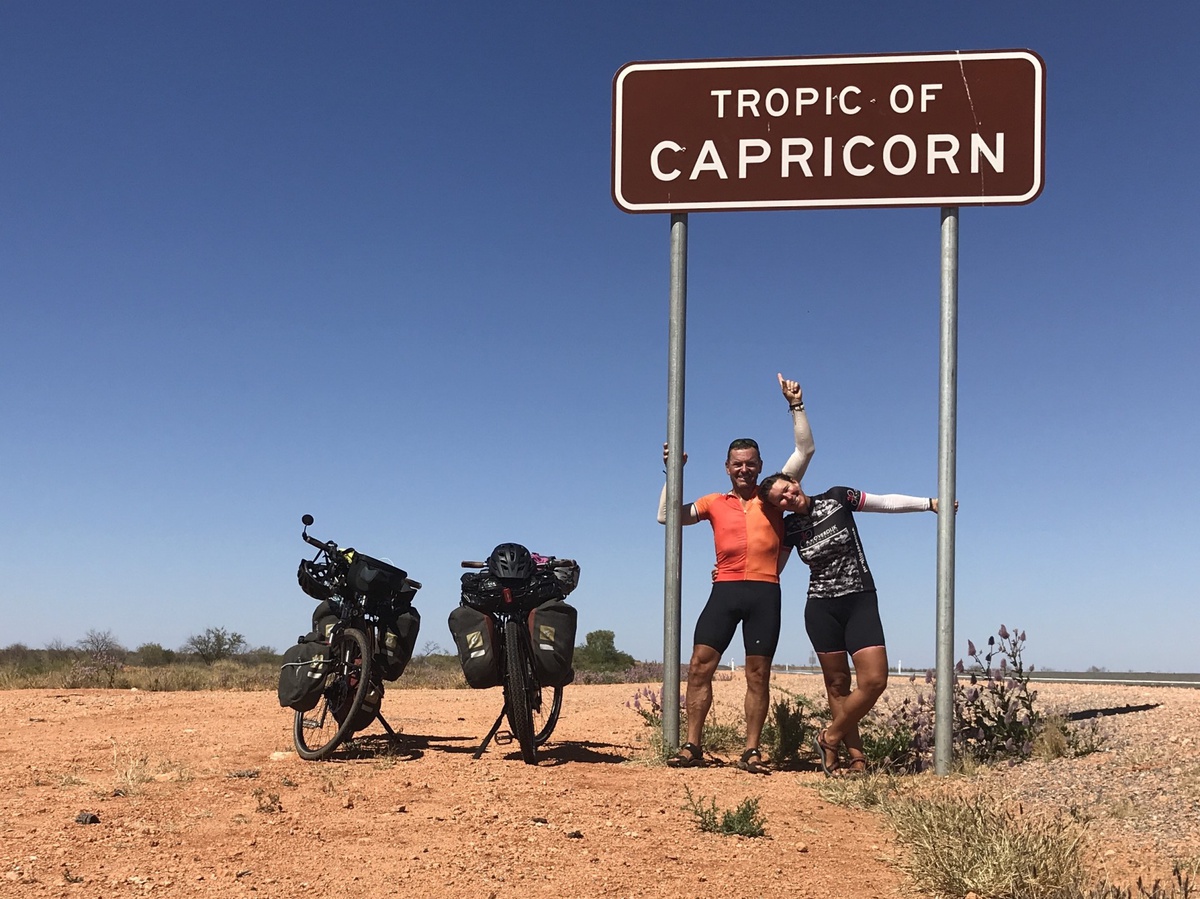
Minilya roadhouse is a horror, too bad to waste words on it. Well, one thing then: the owner is the most stubborn, rude, non-social and customer-unfriendly woman we have met on our trip so far. Fortunately there is also a very sweet backpacking girl from China, who is trying to make something of it. In vain, by the way, but in a month she can also say goodbye to this roadhouse.
Finally we prepare for the last leg to Carnarvon. That will be a struggle, because the (sea) wind comes in this area from the southwest and will become a real obstacle towards midday. The wind does what we expect beforehand: it tries to prevent us from achieving Carnarvon. The last 60 kilometers it attracts a lot and is completely against us. But we have spared our strengths for this part and alternate with each other so that the person in the second position tries to get a bit of relieve.
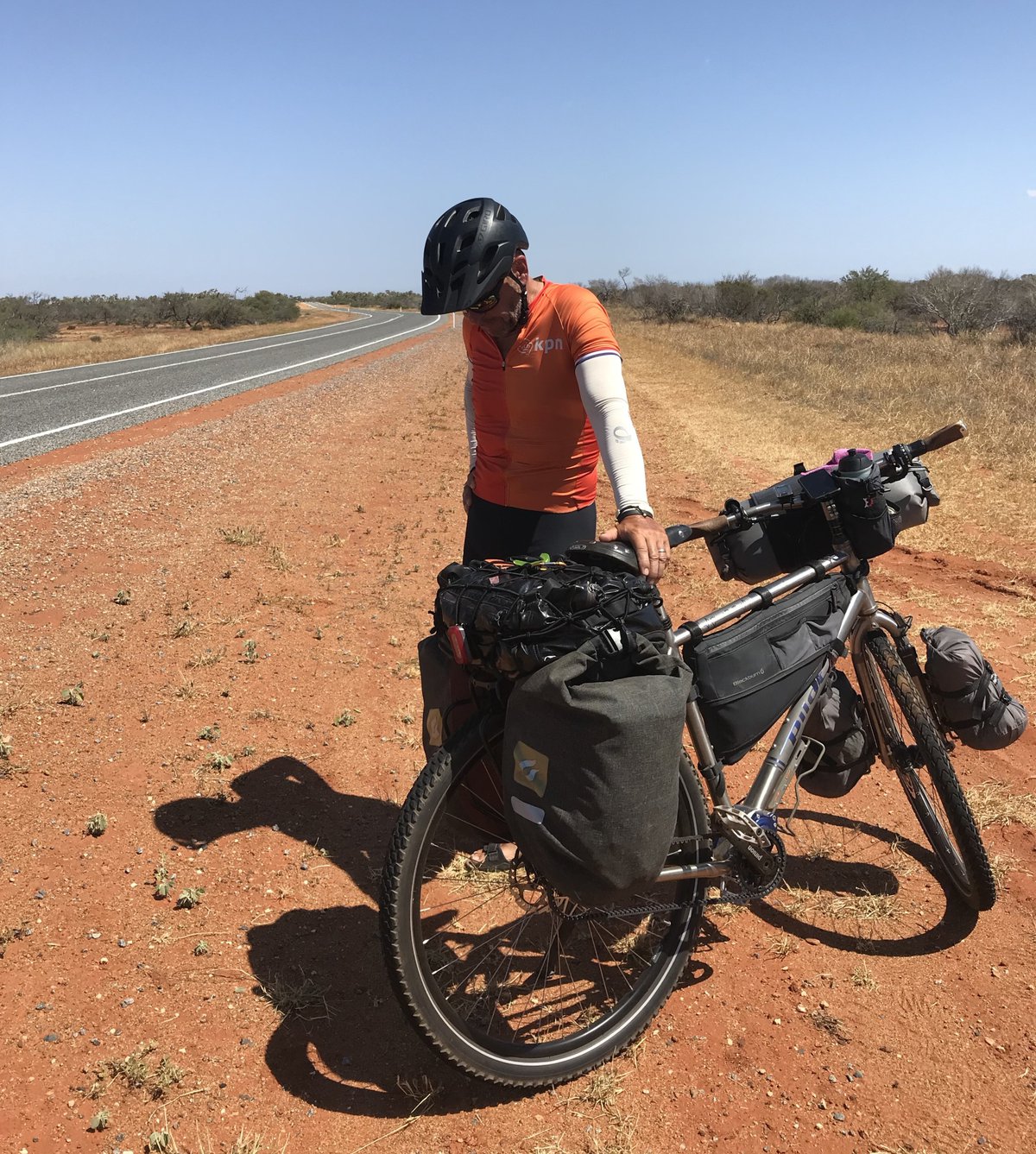
With difficulty we reach the first signs of civilization, the Northern Plantations: a horticultural area with fruit and vegetable cultivation: bananas, papayas, tomatoes, mangos, you name it, it is grown here. It produces an image that we have not seen so far on our journey through Australia. After these plantations we cycle into the town, which seems to consist mainly of Caravan Parks and has little else to do. We cycle on to the last and probably best caravan park, the luxurious Coral Coast Tourist Park. A place that would normally cost us a fortune, but we can pitch our tent for free! The owners, Nic and Donna, are members of the Warm showers, the worldwide network of cyclists who give each other shelter. Unfortunately, they are on vacation themselves, so that we cannot get to know our benefactors.
So we have succeeded in bridging that final stage of 140 kilometers and covered the distance from Karratha in five instead of six stages. 650 kilometers in five stages (130 on average), we think that is not normal, just like 1525 kilometers in the thirteen stages of this blog (117 on average); it will come through that Hulk powder. Hulk powder or not, we think we have earned one or two days of rest in Carnarvon before we prepare for the last 1000 kilometers to Mandurah, the suburb of Perth where family live.
